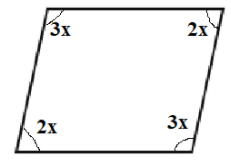
The measure of two adjacent angles of a parallelogram is in ratio 3:2. Find the measure of each of the angles of the parallelogram.
Answer
576.6k+ views
Hint: The opposite angles of the parallelogram are equal, and the total sum of all the angles of the parallelogram is equal to ${360^ \circ }$. Let the two adjacent angles of the parallelogram be $3x$ and $2x$ and solve for the $x$ using the mentioned properties of a parallelogram.
Complete step by step solution: It is given that the ratio of the two adjacent angles of the parallelogram is 3:2.
Let us consider the common factor of the ratio of the two adjacent angles of the parallelogram by $x$.
Thus the two adjacent angles of the parallelogram become $3x$ and $2x$.

It is known that the opposite angles of the parallelogram are equal. Therefore the other two angles of the parallelogram must be equal to the $3x$ and $2x$.
Thus the four angles of the parallelogram become $3x$, $2x$, $2x$ and $3x$.
It is also known that the total sum of the interior angles of any polygon with four sides is ${360^ \circ }$.
Thus the sum of $3x$, $2x$, $2x$ and $3x$ is equal to 360°.
$3x + 2x + 2x + 3x = {360^ \circ }$
Solving for $x$, we get,
$10x = {360^ \circ }$
Dividing the equation throughout by 10
$x = {36^ \circ }$
Substituting the value 36 for $x$ to find the angles of the parallelogram we get,
$2x = 2\left( {36} \right) = {72^ \circ }$ and $3x = 3\left( {36} \right) = {108^ \circ }$
Hence, the angles are ${108^ \circ },{72^ \circ },{108^ \circ },{72^ \circ }$
Note: Since the opposite angles of the parallelogram are equal and the total sum of all the four angles of the parallelogram is ${360^ \circ }$, the sum of the adjacent angles of the parallelogram must be equal to ${180^ \circ }$.
Complete step by step solution: It is given that the ratio of the two adjacent angles of the parallelogram is 3:2.
Let us consider the common factor of the ratio of the two adjacent angles of the parallelogram by $x$.
Thus the two adjacent angles of the parallelogram become $3x$ and $2x$.

It is known that the opposite angles of the parallelogram are equal. Therefore the other two angles of the parallelogram must be equal to the $3x$ and $2x$.
Thus the four angles of the parallelogram become $3x$, $2x$, $2x$ and $3x$.
It is also known that the total sum of the interior angles of any polygon with four sides is ${360^ \circ }$.
Thus the sum of $3x$, $2x$, $2x$ and $3x$ is equal to 360°.
$3x + 2x + 2x + 3x = {360^ \circ }$
Solving for $x$, we get,
$10x = {360^ \circ }$
Dividing the equation throughout by 10
$x = {36^ \circ }$
Substituting the value 36 for $x$ to find the angles of the parallelogram we get,
$2x = 2\left( {36} \right) = {72^ \circ }$ and $3x = 3\left( {36} \right) = {108^ \circ }$
Hence, the angles are ${108^ \circ },{72^ \circ },{108^ \circ },{72^ \circ }$
Note: Since the opposite angles of the parallelogram are equal and the total sum of all the four angles of the parallelogram is ${360^ \circ }$, the sum of the adjacent angles of the parallelogram must be equal to ${180^ \circ }$.
Recently Updated Pages
Master Class 9 Social Science: Engaging Questions & Answers for Success

Master Class 9 Science: Engaging Questions & Answers for Success

Master Class 9 English: Engaging Questions & Answers for Success

Master Class 9 Maths: Engaging Questions & Answers for Success

Master Class 9 General Knowledge: Engaging Questions & Answers for Success

Class 9 Question and Answer - Your Ultimate Solutions Guide

Trending doubts
Which places in India experience sunrise first and class 9 social science CBSE

Fill the blanks with the suitable prepositions 1 The class 9 english CBSE

Write the 6 fundamental rights of India and explain in detail

Difference Between Plant Cell and Animal Cell

What is pollution? How many types of pollution? Define it

What is the Full Form of ISI and RAW




